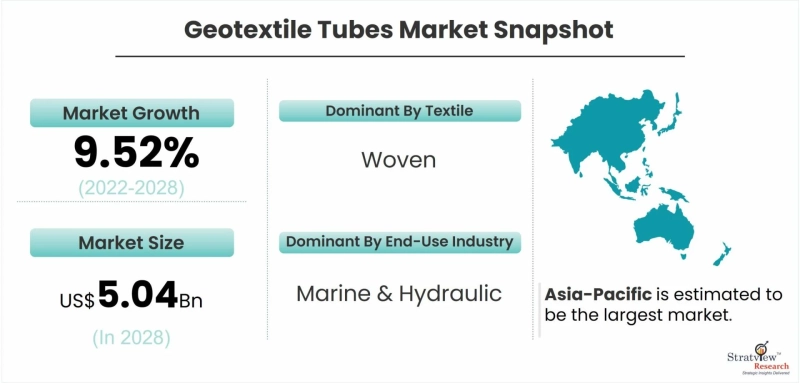The geotextile tubes market is experiencing dynamic changes as it navigates through various opportunities and challenges. These large fabric tubes, filled with sand or other materials, are utilized for applications such as shoreline protection, erosion control, dewatering, and infrastructure reinforcement. Understanding the market dynamics is crucial for stakeholders to capitalize on emerging opportunities and mitigate potential challenges.
According to Stratview Research, the geotextile tubes market was estimated at USD 2.65 billion in 2021 and is likely to grow at a CAGR of 9.52% during 2022-2028 to reach USD 5.04 billion in 2028.
Opportunities
Environmental Sustainability and Climate Adaptation
With increasing awareness of environmental sustainability and the need for climate adaptation, geotextile tubes present significant opportunities. These tubes offer eco-friendly solutions for erosion control and shoreline stabilization, blending seamlessly with natural landscapes. As climate change intensifies and coastal areas face rising sea levels and severe storms, the demand for effective and sustainable protection measures grows. Geotextile tubes provide a viable option for safeguarding coastlines and promoting environmental conservation.
Infrastructure Development and Urbanization
The rapid pace of urbanization and infrastructure development presents a substantial opportunity for the geotextile tubes market. Urban expansion and the need for robust infrastructure necessitate reliable solutions for soil stabilization, embankment reinforcement, and flood control. Geotextile tubes are increasingly being used in these applications due to their versatility and effectiveness. As emerging economies invest heavily in infrastructure projects, the demand for geotextile tubes is set to rise, offering significant market growth potential.
Technological Innovations
Advancements in geotextile materials and manufacturing technologies are unlocking new opportunities. Innovations such as high-strength geotextiles, improved filtration capabilities, and enhanced durability are expanding the range of applications for geotextile tubes. These technological improvements make geotextile tubes more efficient and reliable, attracting interest from various sectors, including mining and industrial dewatering projects. The continuous development of new and improved geotextile products is expected to drive market growth.
Challenges
High Initial Costs
One of the primary challenges in the geotextile tubes market is the high initial costs associated with their installation. Despite being cost-effective in the long term, the upfront investment can be a barrier for some projects, particularly in regions with limited financial resources. Overcoming this challenge requires demonstrating the long-term benefits and cost savings associated with geotextile tubes to potential stakeholders.
Regulatory and Environmental Concerns
Regulatory and environmental concerns can pose challenges to the market. Compliance with environmental regulations and obtaining necessary permits for geotextile tube installations can be time-consuming and complex. Additionally, there may be concerns about the long-term environmental impact of geotextile materials. Addressing these challenges involves ensuring regulatory compliance, conducting thorough environmental impact assessments, and promoting the use of biodegradable and eco-friendly geotextile materials.
Technical Expertise and Skilled Labor
The installation and maintenance of geotextile tubes require technical expertise and skilled labor. The lack of trained professionals in certain regions can hinder the successful implementation of geotextile tube projects. Investing in training programs and building a skilled workforce is essential to overcome this challenge and ensure the effective use of geotextile tubes.
Conclusion
The geotextile tubes market is poised for significant growth, driven by opportunities in environmental sustainability, infrastructure development, and technological innovations. However, stakeholders must navigate challenges such as high initial costs, regulatory concerns, and the need for technical expertise. By addressing these challenges and capitalizing on emerging opportunities, the geotextile tubes market can achieve sustained growth and contribute to a more resilient and sustainable future.


